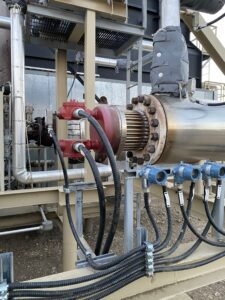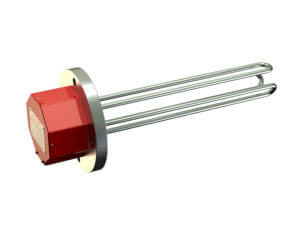A Closer Look at the Efficiency of Flanged Heaters
Last updated on March 26th, 2024 at 01:28 pm
Are you unsatisfied with your current methods for process heating? Maybe you need something more durable or more efficient. You may want to switch to electric heat and flange mount heating units are an excellent selection. In fact, they are highly efficient and may save you a lot of money over the course of time.
What are Flanged Heaters?
 Flange heaters get their name from their distinctive flange mounts. They are electric heaters which work on the principle of immersion. When you immerse a heating element in a liquid it heats it evenly. Also, electricity is one of the cleanest ways to heat materials.
Flange heaters get their name from their distinctive flange mounts. They are electric heaters which work on the principle of immersion. When you immerse a heating element in a liquid it heats it evenly. Also, electricity is one of the cleanest ways to heat materials.
To make a flange heater, a heating element is connected to a flange which is ANSI (American National Standards Institute) rated. ANSI is an important organization that helps to set US industry standards. With direct heat flange heaters, the elements come in contact with the liquid to be heated. A temperature sensing unit is also mounted with the element and sends important date to the control panel, mounted externally. Readings from the units are easily transferred to the temperature control unit via wires.
Indirect flange heaters are completely encased in protective tubing, and although the heating elements are not actually in the liquid, the liquid is heated through convection, radiation, and conduction. Most flange heaters are protected from overload by high limit switches which cut power to the elements when maximum current is drawn. This not only protects the unit but also serves to keep it from overheating your liquids or gases.
Why Are Flanged Heaters So Efficient?
When you invest in flange type heaters you will enjoy many benefits including efficiency. Here are some of the ways you can have a more efficient operation and save on costs.
Easy to Install
Installation of flange heating units is not difficult. In fact, it’s not hard to retrofit installations when changing over from gas heat. You can order flange heaters to fit the old burner areas, and because they are flange installed, there may be no need to make a lot of modifications to your tanks.
Many units can be installed so they can be removed without the need to drain the tank and shut down an important process of your operation. Plus, you can order heating units with flanges already welded on. However, if you have already have flange mounts on your tank, adapter flange mounts can be welded to them.
Easy to Operate
Thanks to digital heating technology, it’s very easy to track temperatures. One does not have to know a great deal about the system to take accurate readings and record them. The units function fully automatically with no need to adjust settings once set.
Easy to Maintain
When you use fla nge heaters, there is not a great deal of maintenance to be concerned with. High quality units are made with the best materials and when you choose the right sheathing you can enjoy years of dependable service. However, nothing lasts forever, and you may eventually have the need to change out flange heating units. This is easily done by simply removing the element and replacing it.
nge heaters, there is not a great deal of maintenance to be concerned with. High quality units are made with the best materials and when you choose the right sheathing you can enjoy years of dependable service. However, nothing lasts forever, and you may eventually have the need to change out flange heating units. This is easily done by simply removing the element and replacing it.
When you save money on maintenance, you increase efficiency. By not incurring downtime with flange heater maintenance, you can save your company a lot of money. Plus, long lasting units do not need replacement very often and this is another way to lower your operating costs.
Efficient Heating
Flange heaters allow for precise heat control. This helps to keep heating costs down. In addition, precise heat is needed in many commercial applications and with the help of digital control units, your fluids will be the perfect temperature when needed.
Flange immersion heat is one of the most efficient ways you can heat liquids. With gas heat, you lose a great deal of the heat from the burners and they will heat up the environment considerably with the heat loss. With immersion flange heaters powered by electricity, you have no kind of heat loss to be concerned with. Your liquids receive all of the heat generated by the units. This is a great way to save on energy and you will keep the ambient temperature to a minimum which is an added benefit for hot environments. These are some of the reasons you will see more flange type heaters in industry today.
EPA Considerations
In some cases, you may have issues with pollution. Since flange immersion heaters are powered by electricity, you will not be releasing pollutants into the air. This is one of the cleanest ways to heat and also one of the most efficient methods.
Voltage Choices
Small units can run on single phase electricity. However, you will probably want to install flange heaters that work on three phase power. Three phase power is far more efficient than single phase. You have more consistent delivery of voltage to your sources. In addition, three phase power requires smaller conductors, and this can save on costs.
Element Selections
Depending on your applications, you may need special heating elements. Here are some of the choices you have:
- Steel – these are standard elements and made for non corrosive environments.
- Copper – one of the best conductors and will deliver a high rate of heat transfer, and also resistant to corrosion.
- Stainless steel – highly resistant to corrosion.
- Incoloy – known as a super alloy and has incredible corrosion resistance. Some of these nickel alloys are resistant to acids.
- Inconel this nickel chromium alloy is suited for very corrosive environments.
- Titanium – not only highly resistant to corrosion but very light in weight.
Heat Control Options
When you order your flange heaters you will receive these options for controls:
- Thermocouple – standard way of measuring heat. A thermocouple uses two different metals and when heat is applied, electrical current is produced in proportion to the heat.
- Thermostat – utilizes dissimilar metals to control the flow of liquid while heated.
- RTD – Resistance Temperature Detector – when certain metals (like nickel, copper, or platinum are subjected to heat, resistance is created and this can be measured.
- Digital – uses electronic thermostats for accurate heat control.
